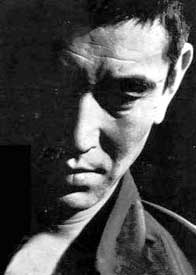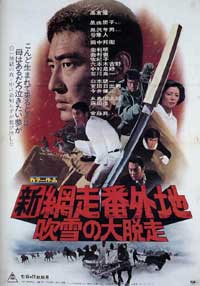The trailer for Shin Abashiri Bangaichi: Fubuki no dai-dasso (New Abashiri Prison: Great Escape in a Snow Storm aka The Great Escape in a Blizzard, Toei, 1971) boasts of a cast of "numerous commedians" & indeed this film fails to take itself seriously most of the time. Ken Takakura is not the pensive, tormented yakuza we usually see (& as shown in a portrait here at the right, not his Abashiri Prison character), but a goofy thug who has spent most of the last sixteen years in prison.
The setting is 1947 & we're told that in Tokyo, girls of the pleasure district have of late doffed kimono in favor of western skirts, & the streets until "stolen" by American GIs, & "In a few years, Japan will be full of half-bloods." A half-blood in the prison provides one of several internal stories.
 The film takes place almost exclusively in prison. The villain is an evil s.o.b. of a gambling boss who got sent up for thirty years, but who has gained so much control of the prison that he is exploiting prison labor & spending his thirty years making plenty of money. He has a disgusting effeminate lover & the parody of homosexuality is quite derogatory to gays. The heroic homosocial bonding of so many ninkyo yakuza or chivalrous gambler films is undermined by this overt expression of gangster homosexuality. The film takes place almost exclusively in prison. The villain is an evil s.o.b. of a gambling boss who got sent up for thirty years, but who has gained so much control of the prison that he is exploiting prison labor & spending his thirty years making plenty of money. He has a disgusting effeminate lover & the parody of homosexuality is quite derogatory to gays. The heroic homosocial bonding of so many ninkyo yakuza or chivalrous gambler films is undermined by this overt expression of gangster homosexuality.
Ken Takakura remains too goofy a character to express love, platonic or brotherly, with his fellow inmates, which further undermines the subliminal homosexuality of so many yakuza heroes. So we're left with more of a western-seeming prejudiced portrait of of homosexuality as a villainous trait.
Eventually the action moves to outside the prison, but despite the title The Great Escape for this episode of the series, escape was never an issue. The movie is such a piece of hackwork that no one even checked what the plot was before titling it & preparing the trailer which indicated it'd be a story abouta great escape from a horrific prison.
The plot seems to have been made up as it was being filmed. The jokes are not funny. The serious aspects of the film are ruined by all the clowning around. The lady doctor love inrterest is totally from left field. And when all the good guys except Takakura have been killed by the bad guyis & it is revenge time the story becomes increasingly idiotic.
All the villains conventiently show up at the same place without any apparent reason. Ken Takakura just as conveniently locates a horse in the middle of nowhere to ride to the scene of impending slaughter. The bad-guys have got a bunch of swords from out of the blue, though nobody had any previously.
Takakura is much less graceful than usual in dispatching everyone bloodily. The chief villain wears a Chinese style costume with coon-skin Davey Crocket cap, & is cut down as red beans fall from a storage bin upon his head, red beans being traditionally used to scare off devils.
The high point of the film came much earlier when another boss, a good guy, has a one-against-all battle in prison. Everyone was armed with scizzors, table knives, & makeshift weapons. The good guy loses in a battle which is completely typical of yakuza tragedy, except that the slashing sound-effects are for scissor strokes & butter knives instead of swords.
The main value this film has is in conveying just how little certain directors cared about the yakuza genre they were instructed to finish under short deadlines, & how incensed some of these directors must have felt over employment that permitted them to do nothing else during the yakuza film craze of the 1960s & early 70s.
1971 was already near the end of this cycle of chivalrous gambler films, & the directors of long-running series films were simply burnt out. The same cliches could be done with respect for the material & actors & many fine films lurk amidst the morass of yakuza-eiga from Toei Studios, but the best ones of their type are from the mid to late 60s. The Great Escape came along too late for anyone involved to give a shit.
Besides the usually appealing Ken Takakura, The Great Escape featured Toshio Kurozawa, Hayato Tani, Rinichi Yamamoto, Kenji Imae, Michitaro Mizushima, & the generally interesting character actor Kunei Tanaka. The Abashiri Prison series consisted of nine films, & the New Abashiri Prison series added eight more, of which The Great Escape was second-to-last. For more about these films, see the article on the first four Abashiri Prison movies & see the review of New Abashiri Prison: Brawl at Cape Shiretoko.
copyright © by Paghat the Ratgirl
|

 The film takes place almost exclusively in prison. The villain is an evil s.o.b. of a gambling boss who got sent up for thirty years, but who has gained so much control of the prison that he is exploiting prison labor & spending his thirty years making plenty of money. He has a disgusting effeminate lover & the parody of homosexuality is quite derogatory to gays. The heroic homosocial bonding of so many ninkyo yakuza or chivalrous gambler films is undermined by this overt expression of gangster homosexuality.
The film takes place almost exclusively in prison. The villain is an evil s.o.b. of a gambling boss who got sent up for thirty years, but who has gained so much control of the prison that he is exploiting prison labor & spending his thirty years making plenty of money. He has a disgusting effeminate lover & the parody of homosexuality is quite derogatory to gays. The heroic homosocial bonding of so many ninkyo yakuza or chivalrous gambler films is undermined by this overt expression of gangster homosexuality.